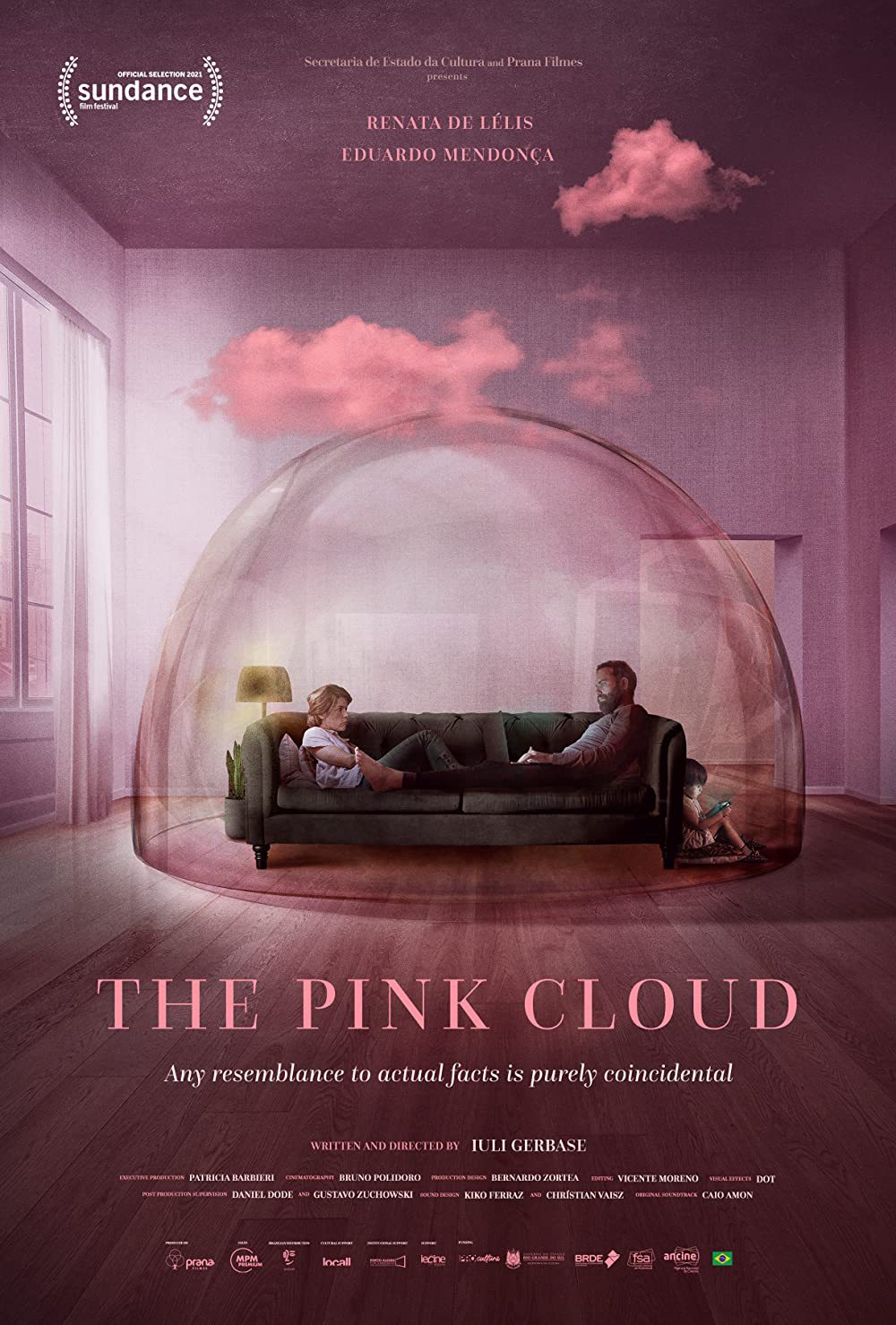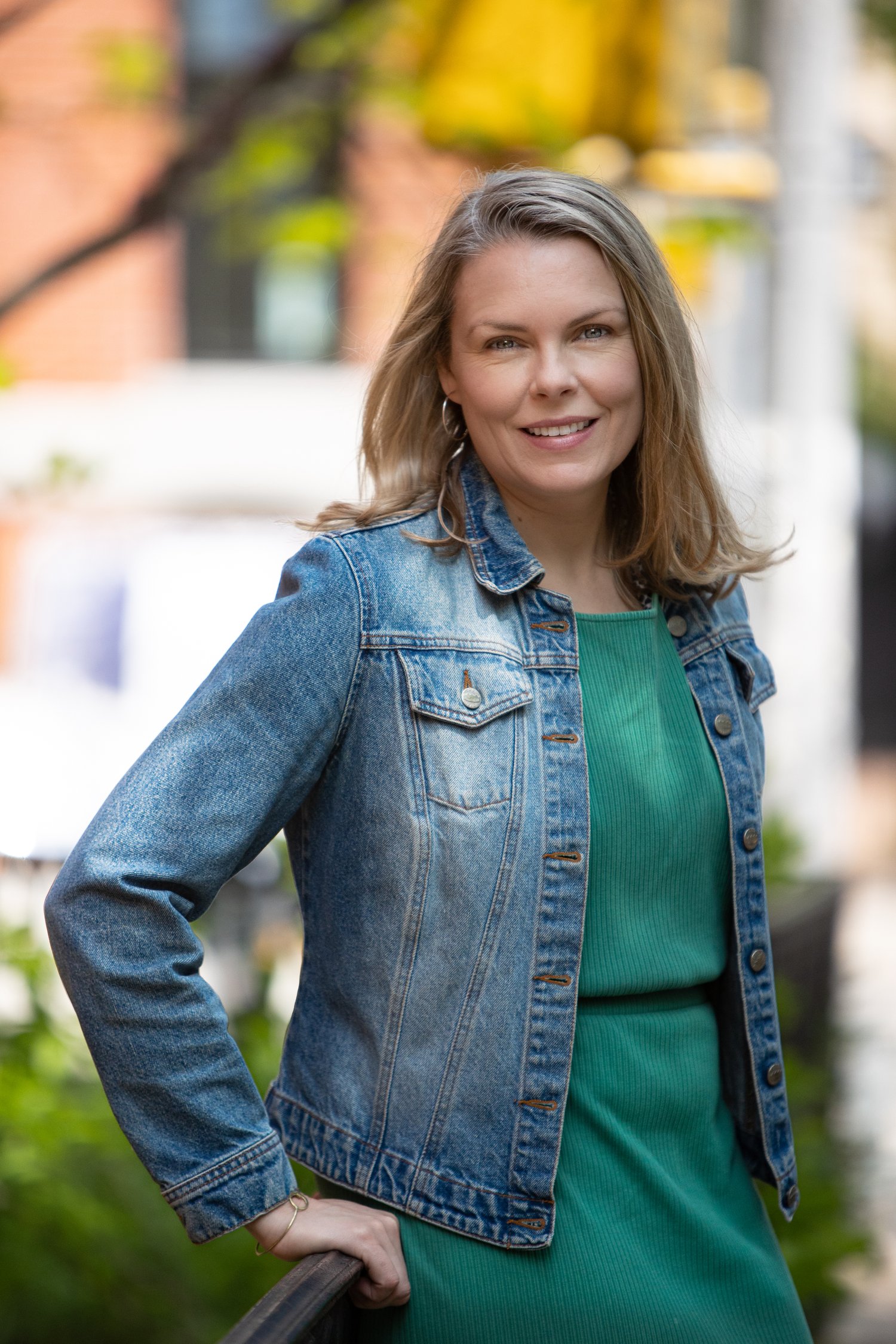Film by IULI GERBASE
Review by HANNAH GERSEN

A title card at the beginning of Iuli Gerbase’s debut feature, The Pink Cloud, informs viewers that its screenplay was written in 2017, and that it was filmed in 2019. What follows is a movie so in tune with the events and moods of 2020 that you would be forgiven for finding this level of prescience impossible to believe. The premise is simple: a toxic pink cloud formation suddenly appears in the sky. Its vapors are deadly, killing people after ten seconds. With only a few minutes of warning, an unnamed Brazilian city is locked down. People are ordered to go indoors immediately; if they are not at home, they are to go into the nearest building, whether it’s a bakery, a grocery store, or the apartment complex they happened to be passing by. Giovana and Yago, the couple at the center of the movie, are on the balcony of Giovana’s apartment when they hear the news, recovering after a late night of partying. We quickly learn that they don’t know each other well; they are waking up from a one-night stand that has been extended indefinitely.
Giovana (Renata de Lélis) and Yago (Eduardo Mendonça) get along with each other well, and the saving grace of this harrowing film is that they don’t end up in an abusive situation, unlike some of their family members who are stranded in different locations. In early scenes, it seems as if The Pink Cloud might evolve into a romantic comedy, tinged with dystopian and sci-fi elements. But the mood quickly becomes claustrophobic and anxious as the pink cloud expands and the lock-down extends for weeks. To feed people, the federal government pioneers a drone delivery system that sends food and supplies via a tube that attaches to residential windows and somehow doesn’t let in enough air to kill anyone. Many of the logistical aspects of this film don’t make a lot of sense when you think about them for more than a minute, but writer and director Gerbase pulls off her story because her psychological observations about a life lived indoors are so acute.
It’s remarkable how accurately Gerbase captures the different moods of life under lockdown. For those of us who lived in an urban place during quarantine, it might hit a little too close to home. Gerbase conveys the early hours of disbelief and even amusement as her characters enjoy the novelty of their situation. Giovana has a Facetime chat with her little sister, who is happy that her stay at a friend’s house will last all day; Yago calls his father to check in and assure him that he’s okay. There’s the pleasant feeling that the situation will resolve itself in due time, like a power outage. Perversely, the pink cloud is very beautiful, and when people stand at the window to look at it, they are bathed in a flattering rosy light. For me—and this is an example of how the film might be too close for comfort—the benign-seeming appearance of the cloud conjured a memory from early in the pandemic when my children would stare out the window into the shared garden of our apartment building. There was a cognitive dissonance as we looked at a landscape that, just a few days before, we had regarded as totally safe.
When the reality of the pink cloud’s permanence sets in, Giovana and Yago attend to logistics: Giovana’s job as a web designer is still viable while Yago, a chiropractor, can’t see patients. They agree to support each other in the ways that they can and joke that they are in an arranged marriage. In this early period of quarantine, they are restless but relatively content; a montage shows them taking up the indoor hobbies we’re all familiar with now that we’re going into our third year of the pandemic: yoga, home repair, deep cleaning, cooking projects, and even dental cleaning aided by YouTube tutorials. Ordering things online via “the tube” becomes a lifeline to the outside world, as do video chats with friends and family.
But after a few weeks—or is it months?—the mood gets darker. It’s hard to keep track of how much time is passing in the world of The Pink Cloud. At first this bothered me, but as the story progressed and the years added up, I felt it was actually an accurate description of how time feels when you’re stuck inside. Gerbase gives us birthdays, including the first birthday of “the cloud,” but the time passed between scenes varies wildly; sometimes it is a few weeks, other times, several months or years. The timeline extends much longer than I expected, so that by the end of the film, Giovana and Yago have been stuck inside for almost a decade; a one-night stands that evolves into a common law marriage. Their sexual relationship ebbs and flows over the years; sometimes sex brings them together, but their sexual appetites also push them apart as they long for other partners. What seems to keep them together long term (aside from being locked up indefinitely) are their differing but complementary temperaments. Yago is the more grounded of the two and we see him practicing a daily gratitude prayer to stay sane. He believes that they can be happy anywhere if they take the right attitude. He’s somewhat passive compared to Giovana, whose restless energy keeps him from becoming complacent. By the same turn, his mellowness is calming to Giovana, who has a harder time coping and longs to return to her old life.
Gerbase’s screenplay does not attend much to the world outside of Giovana and Yago’s domestic bubble, an unusual storytelling choice that forces the viewer to experience the couple’s bewilderment and anxiety first hand. We never learn what the pink cloud is, only that it remains deadly and that there is no safe way to go outdoors. A part of me did wonder how a city could possibly be locked down for such a long period of time without any maintenance workers going outside. I also questioned how the food supply could remain sustainable with no one doing any farming—though perhaps the pink cloud didn’t exist in the countryside? Except for glancing references to failed scientific inquiries, Gerbase doesn’t answer these questions and for the most part, I didn’t feel she needed to, because she gives such a realistic portrayal of the mental health toll. Like the “airborne toxic event” in Don DeLillo’s White Noise, the plausibility of the cloud is not really the point. Instead Gerbase is interested in looking at what happens to people when their domestic space becomes their only landscape—how they do and don’t fall apart.
We feel Giovana and Yago’s psychological pain mostly through the experience of being trapped in a claustrophobic movie with them, seeing the same sets and the same characters, and watching as they desperately try to address their boredom with role-playing games, online dating, and even VR glasses. Their relationships with friends and family, who they keep in touch with online, deteriorate as Yago’s father begins to suffer from dementia, and Giovana’s younger sister is trapped with her friend’s tyrannical and sexually abusive father. There’s a nebulous feeling of loss for the lives they aren’t living and might have enjoyed, if not for the pink cloud. Sadly, I could relate to a lot of what they were going through. The Pink Cloud is being marketed for its eerie prescience, but I’m not sure that’s going to be a selling point for a lot of people. Although it’s a well-made, imaginative film, with distinctive performances from the two leads, watching it felt somewhat masochistic. But it was also therapeutic, like listening to sad music when you’re feeling down. Ultimately, I’m glad I saw it because it helped me to see just how strange and emotionally difficult the past few years have been. But if you’re not ready to go there yet, this might be one to save for a retrospective mood.
Hannah Gersen is the author of Home Field and a staff writer at The Millions. She writes about movies on her blog, thelmaandalice.com, and a monthly newsletter: https://thelmaandalice.substack.com.



![Cover of Showing Up [White, brunette woman behind two small, anthropomorphic sculptures].](https://www.thecommononline.org/wp-content/uploads/2023/06/showing-up-cover-scaled.jpg)
